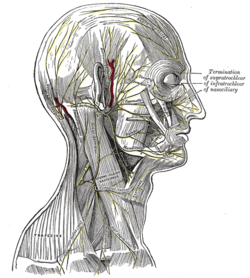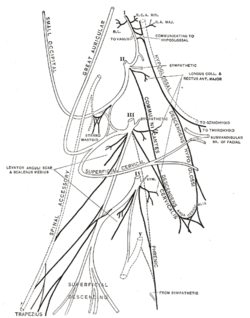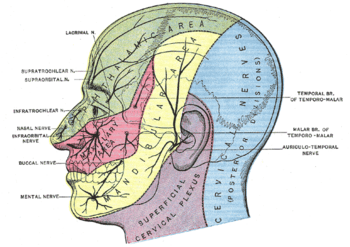Great auricular nerve
| Great auricular nerve | |
|---|---|
 | |
 Plan of the cervical plexus. (Great auricular labeled at top center.) | |
| Details | |
| From | Cervical plexus (C2-C3) |
| Innervates | Cutaneous innervation of the inferior part of the auricle and the parotid region of the face. |
| Identifiers | |
| Latin | nervus auricularis magnus |
| TA | A14.2.02.018 |
| FMA | 6872 |
The great auricular nerve (or greater auricular nerve) originates from the cervical plexus, composed of branches of spinal nerves C2 and C3. It provides sensory innervation for the skin over parotid gland and mastoid process, and both surfaces of the outer ear.
Path
It is the largest of the ascending branches. It arises from the second and third cervical nerves, winds around the posterior border of the Sternocleidomastoideus, and, after perforating the deep fascia, ascends upon that muscle beneath the Platysma to the parotid gland, where it divides into an anterior and a posterior branch.
Branches
- The anterior branch (ramus anterior; facial branch) is distributed to the skin of the face over the parotid gland, and communicates in the substance of the gland with the facial nerve.
- The posterior branch (ramus posterior; mastoid branch) supplies the skin over the mastoid process and on the back of the auricula, except at its upper part; a filament pierces the auricula to reach its lateral surface, where it is distributed to the lobule and lower part of the concha. The posterior branch communicates with the smaller occipital, the auricular branch of the vagus, and the posterior auricular branch of the facial.
Additional images
 Dermatome distribution of the trigeminal nerve
Dermatome distribution of the trigeminal nerve Side of neck, showing chief surface markings.
Side of neck, showing chief surface markings.
References
This article incorporates text in the public domain from the 20th edition of Gray's Anatomy (1918)
External links
- Diagram at aapmr.org
- Anatomy figure: 25:03-03 at Human Anatomy Online, SUNY Downstate Medical Center - "Diagram of the cervical plexus."
This article is issued from Wikipedia - version of the 10/15/2016. The text is available under the Creative Commons Attribution/Share Alike but additional terms may apply for the media files.